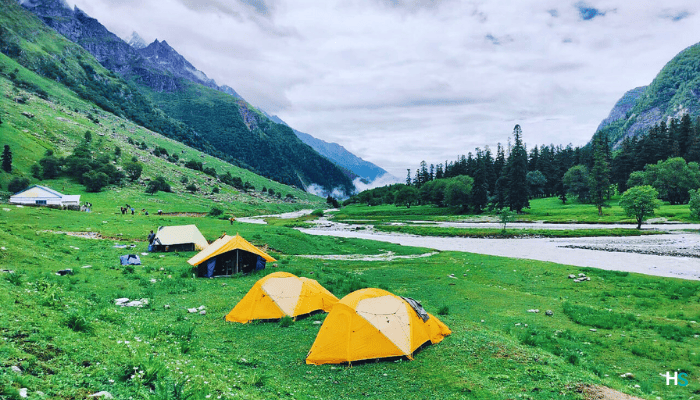
Tosh Valley Trek
TREK DIFFICULTY
Easy
TREK DURATION
2 Days
HIGHEST ALTITUDE
7,900 Feet
GROUP SIZE
12
TREK DISTANCE
5 Km
BASECAMP
Himachal Pradesh
BEST TIME
May | June | July | September | October
PICKUP POINT
Himachal Pradesh
Tosh Valley Trek Overview
Tosh Valley is nestled in the picturesque Parvati Valley is the quaint village of Tosh. Tosh Valley trek is an easy trek that begins in Barshaini. Lush valleys, sprawling meadows, spectacular mountain views and the gushing Tons river, all make this trek an incredible experience. As you reach Tosh village, you’ll be pleased to explore the relaxed vibe of this charming place which is known for its hippie culture. The village also offers breathtaking views of the surrounding mountain ranges. Tosh is located around 20 km from Kasol and 3 km from Barshaini.
Trekking to Tosh Valley is not very difficult, so even beginners, kids and families can enjoy it. Trek usually takes 2 days with an overnight stay in Tosh village. You can find homestays and guest house facilities easily.
During the journey, you will walk through beautiful pine forests, wooden bridges and narrow mountain paths. In Tosh you will see a simple and peaceful village life which will take all your worries away. Colorful flowers, grazing animals and apple orchards give a feel of watching the dreamland stories in real.
The best time to trek to Tosh Valley is from April to October. During this time weather is pleasant. Tosh offers you to feel the real taste of a mountain village life without needing too much trekking experience. It's a perfect weekend escape from the busy lives of cities.
History of Tosh Valley Trek
Tosh village is a simple yet very charming village lying on the slopes of the great Himalayas. It is surrounded by the snow-capped peaks, waterfalls, apple orchards and pine forests. Though there's no particular record of the history of Tosh, it's best known for its beautiful nature around it.
Tosh was believed to be a sacred place in old times. Locals believe that Tosh has been blessed and protected by Lord Shiva. There is also a small temple in the village devoted to Jamadagni Rishi who was a wise sage in Hindu mythology. The villagers still worship here and follow their old traditions.
Tosh remained isolated and untouched for hundreds of years. Only shepherds, wool weavers and some locals knew about this place. They grazed their animals here and grew crops like potatoes and maze. They lived in wooden houses and followed local customs and culture. Their life was difficult but peaceful and they didn't depend on cities for their daily needs. In the late 1990s, Tosh slowly gained recognition by tourists and travelers.
Trekkers who visited Kasol and Kheerganga, also started exploring nearby places like Tosh. Due to its simple and rustic vibes, it became a popular destination. With time, guesthouses, cafes and homestays opened here and locals also got opportunities to grow their source of income.
Though modern tourism brought some changes here, villagers still hold on to their old and traditional lifestyles. Tosh is an amalgamation of old and new and which makes it charming and unique.
Highlights of Tosh Valley Trek
Traditional Himachali Village Life
Tosh village is best known for its beautiful blend of old traditions and rustic mountain living. The lifestyle of villagers is simple yet charming. Wooden houses, locals in traditional Himachali attaires, spiritual inclinations and festivals celebrations, all make Tosh a idyllic village.
Cannabis Fields and Local Beliefs
The wild cannabis plants are naturally grown in the Tosh region. While cannabis is illegal to sell or buy, these fields have shaped local culture and stories. These plants are believed to be linked with Lord Shiva and spiritual practices.
Hippie and Backpacker Culture
Tosh has become a heaven for hippies and global backpackers over the years. Here you will see colorful cafes, trance music and a happy-go-lucky lifestyle. Tosh serves as a beautiful halt from the busy and noisy life of cities. Here time is slowed down and every moment feels like a pause.
Raw & Untouched Nature
Tosh Valley trek stands different from commercial treks. It offers a raw and unspoiled natural beauty combined with Himachali traditions. Though it's very famous among trekkers, you will not see crowd here. Snow-peaked mountains, dense forests, waterfalls and streams, everything is in raw form. The air feels fresh and surrounding peaceful.
Bonfire Nights and Local Stories
Evenings in Tosh are engaged with spotting sunset and nights end with bonfires. Locals tell enchanting stories of myths, spirits and gods. It creates an enjoyable atmosphere and trekkers enjoy it under the starry sky. Next morning, a perfect sunrise awaits you.
Difficulty Level of the Tosh Valley Trek
Located in Parvati Valley, Tosh Valley reaches a maximum elevation of around 2,400 meters (7,874 feet). The trekking here is classified as an easy trek which can be done by beginners, families, kids (above 7) and even solo.
The terrain is covered with dense forests, muddy trails, stone-paved paths and occasional wooden bridges over small streams. Path is mostly well-marked with gentle ascent. Basically, no technical climbing skill is required. Trekkers only need good fitness and stamina.
Tosh Valley is a short trek and takes around 2 days to complete. Total trekking distance from Barshaini to Tosh is about 3-4 km and it takes around 1.5 to 2 hrs to reach the village on foot.
Altitude of Tosh Valley is not so high hence the acclimatization is not a big concern. Trekking is quite manageable and homestays/guesthouses are available as there's no big loaded backpack to carry with.
Tosh Valley is an all-weather trek and can be done even in rain and winter but to avoid slippery trails and heavy snowfall, not recommended in monsoon and winter. However, many trekkers do it in winter time to enjoy snowfall. There can be few moderate challenges in winter but can be easily overcome with mild training and physical fitness.
Best Time to Visit Tosh Valley Trek
The best time to do Tosh Valley Trek is from early summer to late autumn (from April to November). This time weather is pleasant and sky remains clear to view the towering peaks of the Himalayas.
- April to June: After March, winter fades away and the temperature starts becoming normal. The daytime temperature range is between 15°C to 25°C while at night time, it remains around 5°C to 10°C. During these months, the meadows and trails come alive with green landscapes, blooming flowers and flowing waterfalls.
- July to August (Not Recommended): This is the monsoon season so expect heavy rainfall. Some trekkers do trekking during this time for enjoying lush green scenery and challenging trails. However, this time the risk of landslides increases and due to clouds the visibility is reduced. Trails are slippery and leeches are common this time. Beginners and kids should avoid trekking this time.
- September to November: The arrival of winter can make air crisp and trails dry during this time. However, the temperature remains similar to spring 10°C to 20°C in daytime and from 2°C to below 8°C at night. Tourists are fewer and environment is more peaceful. Perfect for photography. In late November, chances of snowfall is also high. Snow lovers can have a chance to view snowfall this time.
How to Reach Tosh Valley Trek
- Tosh Valley is located in the Parvati Valley of Himachal Pradesh. To reach here, start your journey from Bhuntar (Kullu) in Himachal Pradesh.
- Bhuntar is well-connected by road and air. Bhuntar Airport (KUU) is the nearest airport, approx 50 km from Manali. You can also take an overnight Volvo bus from Delhi or Chandigarh to reach Bhuntar.
- From Bhuntar, start driving towards Barshaini (starting point) via Kasol and Manikaran. The drive takes around 4-5 hrs to reach Barshaini and offers glimpses of the Parvati Valley.
- Barshaini is the starting point of the Tosh Valley trek. From here, trek around 3 km (45-60 mins) to reach Tosh. You can also hire a local cab but trekking is more enjoyable due to scenic trails.
Things to Carry in Tosh Valley Trek
- Backpack (20–30L): Lightweight & comfortable
- Valid ID Proof
- 1 warm jacket/fleece
- Thermal innerwear (if trekking in cold season)
- 2-3 quick-dry t-shirts
- Trekking pants (avoid jeans)
- Raincoat (especially in monsoon)
- Woollen cap & sun cap
- Gloves (in winter)
- Extra socks & basic wears
- Good quality trekking shoes with grip
- Light slippers for campsite
- Tent (if not booking through a trek provider)
- Sleeping bag/mat
- Headlamp or torch (with extra batteries)
- Water bottle (minimum 2 litres)
- Electrolytes or ORS
- Energy bars, chocolates, dry fruits
- Toiletries
- Sunscreen
- Basic first aid kit (band-aids, antiseptic, painkiller, Diamox for AMS if going higher)
- Mobile + power bank
- Camera (optional)
- Trekking pole (optional but helpful)
- Small towel or napkin
- Garbage bag (leave no trace)
Barshaini (Starting Point)
- Located 20 km from Kasol, Barshaini serves as the starting point for the trek to Tosh
- You can reach Barshaini by bus or taxi from Kasol, Manikaran or Bhuntar
Trail to Tosh (3–5 km)
- Distance: 3 km via the paved footpath from Barshaini
- Duration: 3–4 hrs to ascend at a moderate pace.
Tosh Village (2,400 m)
- Situated on the right bank of the Parvati River, surrounded by peaks like Papasura, White Sail and Angduri
- Explore local homestays, cafes and the famous Tosh waterfall just outside the village
Optional Extension: Kuta/Kutla or Beyond
- From Tosh, trekkers can extend the route further to Kuta or Kutla villages, adding one more day (6–7 hrs trek)
In Himalaya Shelter, we provide you with the option to customize your Tosh Valley trekking experience. Whether you're a beginner, solo traveller or a group of friends, you can opt for our personalized tailor-made trekking program. This customized trek will be exclusively designed for you, taking into account your specific requirements for transportation, accommodation, meals and any other premium facilities you may need during the trek.
Starting from Barshaini, Tosh Valley trek's trail passes through pine forests, wooden bridges over streams and offers scenic views. Himalaya Shelter ensures your journey is safe and memorable with experienced local guides and all necessary permits. You can even request offbeat routes or sunrise hikes for a more immersive Himalayan experience.
Moreover, no other participants will be added to your group. Choosing a customized trek will enable you to fully enjoy the trek with your loved ones.
Day 1: Barshaini to Tosh | Trek: 2.5 km in 1 hr
Start your trek from Barshaini (2,400 m), a beautiful village at the confluence of the Tosh and Parvati rivers. The short 2.5 km trail to Tosh takes about an hour, winding through pine forests and charming wooden bridges. Tosh (2,800 m) offers stunning views of the Tosh Glacier and nearby peaks. Spend the evening exploring the peaceful village and enjoy a night in a cozy homestay.
Day 2: Tosh to Barshaini | Trek: 2.5 km in 1 hr
Wake up to a Himalayan sunrise and begin your easy return trek to Barshaini. The descent is quick and scenic, letting you bid farewell to the beautiful Parvati Valley. Also, from Barshaini, you can continue your journey to Kasol or Bhuntar.
Our treks are specially designed by the experienced team at Himalaya Shelter taking you on an adventure of a lifetime all while making you connect not only with the bountiful nature but also with yourself and with others on the trek with you creating wonderful memories which will last you a lifetime. All Himalaya Shelter treks are guided by experienced Trekkers having vast knowledge and experience of the region, providing with insightful information and stories pertaining to the region’s flora and fauna and the history of the region whilst the trek. It is safe to say that on successfully completing the trek one will gain tremendous insight and experience along with lifetime memories.
Trek Inclusions
- Transportation - Support from Barshaini.
- Accommodation – At Base Camp, stay at a local homestay or guest house for one night each, which will give you an insight into the authentic lifestyle of the locals.( INR 5000 per person extra for single sharing throughout the trek )
On Trek stay in a 2-person Vango Halo Pro/A-Shape tent, which is to be shared by two trekkers, built to withstand extreme weather conditions and at the same time making you comfortable after a hard day’s trek. - Camping Equipment – specially designed sleeping bags that can withstand harsh weather conditions, foam mattresses. Other safety gear like microspikes, gaiters, an ice axe, and helmets will be provided.
- Medical Kit – our team will be equipped with an extensive medical kit, which our team is trained and experienced to use. Oxygen cylinders are used after they are thoroughly inspected throughout the Trek. Even campsites have large oxygen cylinders as backups.
- Permission - Forest entry charges for Indian nationals (Additional charges will be applicable for international tourists)
- Meals – Breakfast, packed lunch (on trek days), evening snacks, and dinner will be served. A hearty, delicious, and nutrition-filled Veg meals with egg preparation will be provided throughout the trek. (Jain and Vegan Food can also be arranged on prior notification.)There will be a dedicated Kitchen Tent along with a dining tent, which will have a dining table too.
- Our Team – A highly experienced and AMC-certified Trek Leader who will help ensure that the entire trek goes smoothly and safely while navigating the challenging conditions during the trek, and is skilled enough to navigate any medical emergency that can arise during the trek. Local and route Guides who are well-versed with the region and provide an in-depth insight into the local customs and knowledge of the flora and fauna endemic to the region. A dedicated Kitchen staff, which includes a Cook, a helper, and other support staff. There will also be porters and mules to carry common equipment.
- Cloakroom - We have a cloakroom facility available for extra luggage. Every trekker is permitted to leave their luggage behind at no charge.
Trek Exclusions
- Personal expenses like tips, personal medicines, phone calls etc.
- Travel Expenses - Travel expenses from your hometown to the mentioned Pick-Up Point are not included in the trek fee.
From the scheduled pick-up spot to the base camp, we have our own fleet of vehicles like Bolero, Innova, Dezire, or Tempo Traveler (12-seater). This is be shared by trekkers for a pre-decided amount. All vehicles are non-AC. - Personal Equipment - Any personal gear like jackets, shoes, cutlery, or backpacks are not included in the trek fee. We recommend renting them from our Rental Store for an affordable fee. This can be pre-arranged to avoid last-minute hang-ups.
- Offloading - We encourage carrying your backpack to get into the true spirit of trekking. However, if needed, you can opt to offload your personal luggage of up to 12 kgs for an additional cost of INR 500 per bag per day.
- Trek Insurance - A mandatory trek insurance fee is charged in addition to your trek fee. Since most medical insurance doesn’t cover adventure activities, trek insurance offers essential coverage, enhancing your safety without a significant financial burden.
- Buffer day on the trek - We have kept a buffer day on the trek to account for any weather-related delay. If this is utilized, you will need to pay an extra amount to your trek leader.
- Anything apart from inclusions
- Please carry a lunch box for a packed lunch/breakfast to avoid using polythene and Aluminium foil.
Keeping the Himalayas clean is our own responsibility. Reduce the use of Plastic when you are in the abode of the Sacred Himalaya. 🌱
Tosh Valley is in the Parvati Valley, Himachal Pradesh, India.
Around 2,400 meters (7,874 feet) above sea level.
Yes, it’s an easy to moderate trek.
Around 3–5 km, depending on the route.
Approximately 2–4 hours one way.
March to June and September to November.
Yes, camping is allowed at designated spots.
Yes, Tosh has many budget cafes and homestays.
Yes, but it's better to inform someone about your plan.
Not necessary but helpful if unfamiliar.
Limited. Jio and BSNL work better.
Yes, with proper precautions and fitness.
Yes, you can drive up to Tosh village.
No, the nearest ATM is in Kasol or Manikaran.
Read More on Tosh Valley Trek
Treks by Categories
Treks By Month

Treks By Experience










